Section 2 Market environments
Archived Content
Information identified as archived is provided for reference, research or recordkeeping purposes. It is not subject to the Government of Canada Web Standards and has not been altered or updated since it was archived. Please "contact us" to request a format other than those available.
This section describes the market environments in which workplaces operate. In addition to focusing on market geographic scope, shares of sales from all products and services, number of competing firms and intensity of market competition, it provides various indicators of market performance.
2.1 Conditions of the market
In the Workplace and Employee Survey (WES), workplaces were asked to indicate the market areas (local, rest of Canada, United States and rest of the world) in which they sell their products, services or both.
The most striking feature of Table 2.1 is that most workplaces had a predominantly local market scope. The market geographic scope, irrespective of industry and workplace sizes, was most commonly local, followed by the rest of Canada, then United States, and, least commonly, the rest of the world. As workplace size increased, the relative importance of the local market decreased and the relative importance of other markets increased. Larger workplaces tended to engage more in international trade than smaller ones.
Of all workplaces, more than two-thirds sold their products and services in the local market only, whereas almost 30.0% sold their products and services in more than one market.
Workplaces in the manufacturing sector industries, business services, and information and cultural industries tended to compete in all markets, whereas the construction sector was predominantly local.
Turning now to workplaces that were in the sample both in 1999 and 2005, 15.8% reported export activities in 1999. By 2005, this proportion had increased to 18.0%. Workplaces that did not export in 1999 but reported some export activity in 2005 (8.5%) outnumbered those that had exported in 1999 but were not in 2005 (6.3%). Expansion into international market was more likely than retrenchment.
Chart 2.1
Market geographic scope, by workplace size, 2005
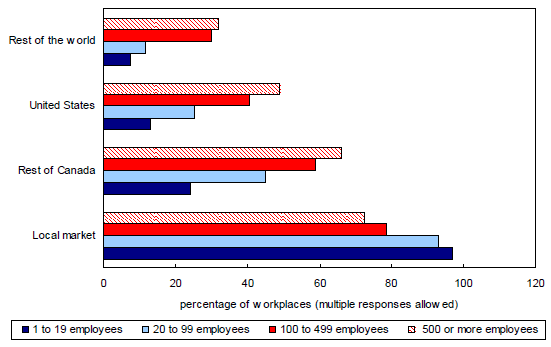
Source: Statistics Canada, Workplace and Employee Survey, Workplace component.
In the WES, workplaces are asked to provide their share of total sales from all products and services, broken down by market area. The most important market is defined as the market that provides the highest percentage of the workplace total sales from all products and services.
The local market was most important, regardless of industry, region or size, providing 85.0% of total sales from all products and services (Table 2.2). The rest of Canada was the second most important (9.2% of total sales). As workplace size increased, the relative importance of the local market decreased and the importance of the other markets increased.
Workplaces with fewer than 20 employees obtained 87.4% of their total sales from the local market and about 5.0% from the United States and the rest of the world markets, whereas workplaces with 500 or more employees obtained about half of their total sales from the local market and about one fourth from other Canadian markets.
Workplaces in the manufacturing, transportation, warehousing and wholesale trade, and, information and cultural industries differed from the other industries as they had larger shares of sales resulting from selling their products and services in the rest of Canada and in the United States. The primary, secondary and capital-intensive tertiary manufacturing industries were among those with the highest shares in the United States market; whereas the construction, education and health services, non-profit groups industries had the lowest market shares in those markets.
Chart 2.2
Share of sales from all products and services, by market area and workplace size, 2005
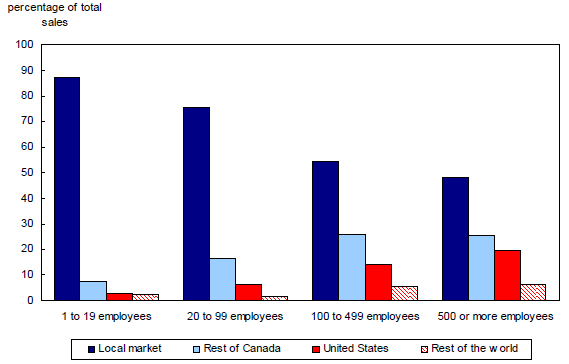
Source: Statistics Canada, Workplace and Employee Survey, Workplace component.
Looking at the data for workplaces that were in the sample in 1999 and that were still in the sample in 2005 allows us to focus on changes in market performance as measured by change in shares of sales from all products and services in all markets between these two years among the same workplaces. (Table 2.3)
The overall distributions of shares of sales from all products and services showed some noticeable changes between 1999 and 2005. The share of sales in local markets dropped and the share in international markets increased. Still, the local market provided the highest percentage of sales. The market constituted by the rest of Canada remained the second most important. As observed previously, as workplace size increased, the relative importance of the local market decreased and the relative importance of the other markets increased.
From 1999 to 2005, the relative share of sales for workplaces with 20 employees or less decreased in the local market and increased in all other markets. Workplaces with 500 employees or more saw sales increasing in the local and the rest of the world markets, and decreasing in the rest of Canada and the United S markets.
Of all industries, business services industries had the highest gain in share of sales in the rest of the world market. Information and cultural industries had the highest gain in share of sales in the United States market.
Chart 2.3
Share of sales from all products and services, by market area, 1999 and 2005
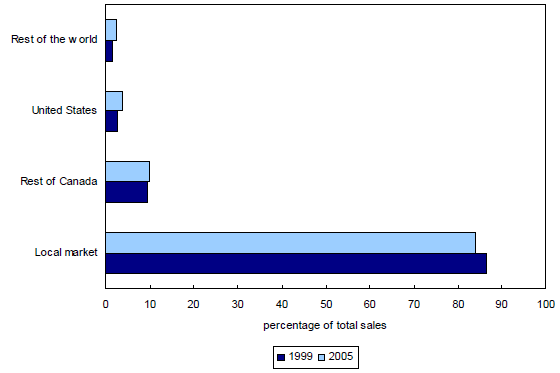
Source: Statistics Canada, Workplace and Employee Survey, Workplace component.
Workplaces were also asked to indicate the number of firms, whether based in Canada or not, that offer products and services directly competing with them in their most important market. The most important market is represented by the market that provides the highest percentage of sales from all products and services. (Table 2.4)
Over a third of the workplaces in the following industries reported they operated in markets with 20 or more competing firms: real estate, rental and leasing operators (38.0%), business services (37.6%), construction (35.6%) and finance and insurance (35.4%), whereas information and cultural, primary product manufacturing and capital intensive tertiary manufacturing industries had a large number of workplaces operating in markets with few competitors (60.8%, 55.8% and 46.8% respectively).
Some noticeable changes in the workplaces competitive environment were observed between 1999 and 2005. Of all workplaces that were in an environment characterized by the absence of competition in 1999 (13.1%), only 39.5% remained in that same environment in 2005, indicating a decrease in market power for about 6 out of 10 of these workplaces.
Similarly, of all workplaces that faced direct competition in at least one market in 1999 (87.0%), the majority (89.0%) remained in that the same environment in 2005, indicating a shift toward markets characterized by lack of competition for only 1 out of 10 of these workplaces.
While the majority (82.0 % ) of workplaces that were in the sample both in 1999 and 2005 remained in markets characterized by the same number of competing firms, 10.0% made a shift toward markets where there was no competition, indicating some gains in market power and 8.0% made a shift toward markets where they experienced varying degrees of competition.
Chart 2.4
Number of firms directly competing in most important markets, by workplace size, 2005
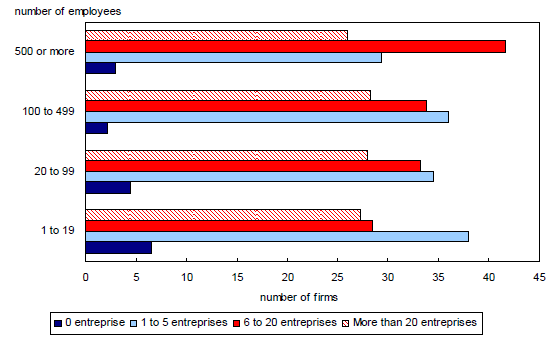
Source: Statistics Canada, Workplace and Employee Survey, Workplace component.
2.2 Competition and market performance
Next, we examine how the intensity of market competition affects market performance. WES respondents were asked about the importance of competition using a 5-point importance scale with (1) being not important and (5) being crucial. This scale reflects the intensity of market competition. The maximum reported value was used, irrespective of the source of the competition. Significant competition refers to a situation where another firms' products and services similar to a workplace's products and services could be purchased by the same customers.
Almost all (95.7%) workplaces reported facing competition varying from slightly important to crucial in their products-markets and almost one in five indicated that competition was crucial.
As the perceived degree of competitive pressures increased from important to crucial, more workplaces reported having productivity, profitability and sales growth levels higher than their main competitors.
Workplaces that reported higher levels of profitability than their main competitors were fewer than those reporting higher productivity levels than their main competitors.
Table 2.5 Market performance, by importance of competition and workplace size , 2005
Chart 2.5
Market performance, by competition importance, 2005
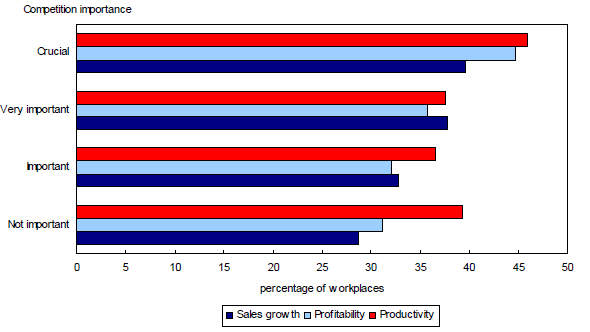
Source: Statistics Canada, Workplace and Employee Survey, Workplace component.
- Date modified:
